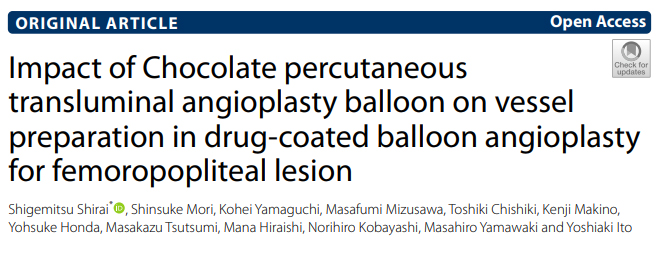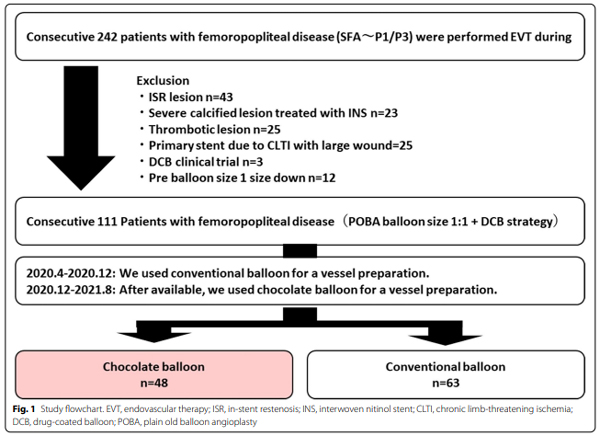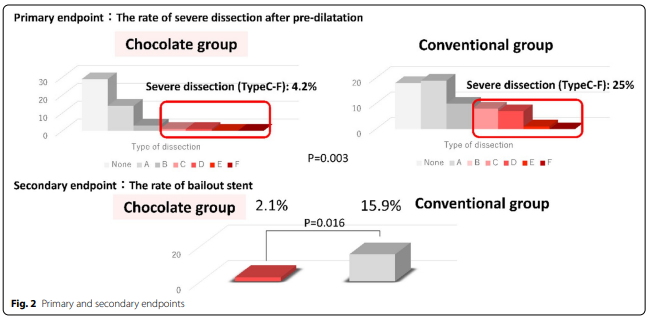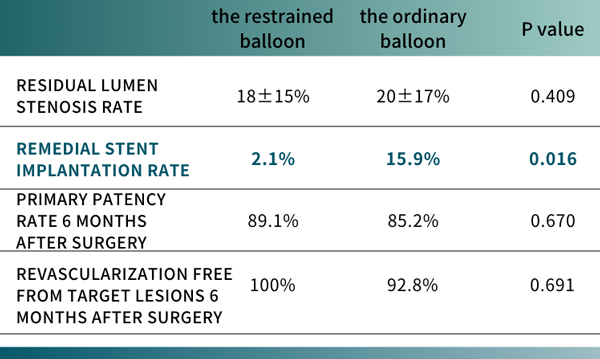
Background and purpose
After the advent of drug-carrying devices, the concept of “vessel preparation” has been paid more attention, and good vascular preparation can improve the effectiveness of stents/DCB. Professor Shigemitsu Shirai’s team at the Department of Cardiology, Saiseikai Yokohamashi Tobu Hospital, Yokohama, Japan, conducted a retrospective study to compare the effects of a restrained balloon versus a conventional balloon on vessel preparation for femoral-popliteal artery angioplasty.
Research method
The center retrospective study included 111 patients with femoral-popliteal artery disease who were treated with DCB and had a pre-dilated balloon diameter ratio of 1:1 between February 2020 and August 2021. According to the types of predilation balloon, they were divided into the constraint balloon group (n=48) and the ordinary balloon group (n=63). The primary endpoint was the incidence of severe dissection after predilection. Secondary endpoints were the rate of residual lumen stenosis after predilation, the rate of remedial stent implantation, the rate of primary patency 6 months after surgery, and the rate of revascularization free from target lesions.

Research result
1. There were no significant differences in baseline data and lesion characteristics.
2. Surgical and angiographic features:
There was no significant difference in balloon diameter between the restrained balloon group and the ordinary balloon group, and the balloon length was 90±37 mm and 148±95 mm, respectively (P=0.004). The expansion pressures were 11±3 atm and 16±7atm respectively (P < 0.001).

3.Main evaluation index
the restrained balloon group: Incidence of severe dissection rate4.2%
the ordinary balloon group: Incidence of severe dissection rate25%
Remedial stent implantation rate
P value:0.003
4.Secondary evaluation index

Conclusion
The restrained balloon reduces the incidence of severe dissection while maintaining adequate dilation during the preparation of the drug-coated balloon for treating femoral-popliteal artery disease.
References
●Aboyans V, Ricco JB, Bartelink MEL et al (2018) 2017 ESC Guidelines on the Diagnosis and Treatment of Peripheral Arterial Diseases, in collaboration with the European Society for Vascular Surgery (ESVS): Document covering atherosclerotic disease of extracranial carotid and vertebral, mesenteric, renal, upper and lower extremity arteriesEndorsed by: the European Stroke Organization (ESO)The Task Force for the Diagnosis and Treatment of Peripheral Arterial Diseases of the European Society of Cardiology (ESC) and of the European Society for Vascular Surgery (ESVS). Eur Heart J. 39:763–816. https://doi.org/10.1093/eurheartj/ehx095
●Bisdas T, Beropoulis E, Argyriou A, Torsello G, Stavroulakis K (2018) 1-Year allcomers analysis of the eluvia drug-eluting stent for long femoropopliteal lesions after suboptimal angioplasty. JACC Cardiovasc Interv. 11:957–66. https://doi.org/10.1016/j.jcin.2018.03.046
●Feldman DN, Armstrong EJ, Aronow HD et al (2018) SCAI consensus guidelines for device selection in femoral-popliteal arterial interventions. Catheter Cardiovasc Interv. 92:124–40. https://doi.org/10.1002/ccd.27635
●Fujihara M, Takahara M, Sasaki S et al (2017) Angiographic dissection patterns and patency outcomes after balloon angioplasty for superfcial femoral artery disease. J Endovasc Ther. 24:367–75. https://doi.org/10.1177/1526602817698634
●Iida O, Takahara M, Soga Y et al (2014) Shared and diferential factors infuencing restenosis following endovascular therapy between TASC (TransAtlantic Inter-Society Consensus) II class A to C and D lesions in the femoropopliteal artery. JACC Cardiovasc Interv. 7:792–8. https://doi.org/10.1016/j.jcin.2014.01.168
●Laird JR, Katzen BT, Scheinert D et al (2010) Nitinol stent implantation versus balloon angioplasty for lesions in the superfcial femoral artery and proximal popliteal artery: twelve-month results from the RESILIENT randomized trial. Circ Cardiovasc Interv. 3:267–76. https://doi.org/10.1161/CIRCINTERVENTIONS.109.903468
●Micari A, Vadalà G, Castriota F et al (2016) 1-Year results of paclitaxel-coated balloons for long femoropopliteal artery disease: evidence from the sfa-long study. JACC Cardiovasc Interv. 9:950–6. https://doi.org/10.1016/j.jcin.2016.02.014
●Mustapha JA, Lansky A, Shishehbor M et al (2018) A prospective, multi-center study of the chocolate balloon in femoropopliteal peripheral artery disease: The Chocolate BAR registry. Catheter Cardiovasc Interv. 91:1144–8. https://doi.org/10.1002/ccd.27565
●Norgren L, Hiatt WR, Dormandy JA et al (2007) Inter-society consensus for the management of peripheral arterial disease (TASC II). J Vasc Surg. 45(Suppl S):S5–S67. https://doi.org/10.1016/j.jvs.2006.12.037
●Ranke C, Creutzig A, Alexander K (1992) Duplex scanning of the peripheral arteries: correlation of the peak velocity ratio with angiographic diameter reduction. Ultrasound Med Biol. 18:433–40. https://doi.org/10.1016/0301-5629(92)90082-l
●Rocha-Singh KJ, Zeller T, Jaf MR (2014) Peripheral arterial calcifcation: prevalence, mechanism, detection, and clinical implications. Catheter Cardiovasc Interv. 83:E212-20. https://doi.org/10.1002/ccd.25387
●Rogers JH, Lasala JM (2004) Coronary artery dissection and perforation complicating percutaneous coronary intervention. J Invasive Cardiol 16:493–499Scheinert D, Scheinert S, Sax J et al (2005) Prevalence and clinical impact of stent fractures after femoropopliteal stenting. J Am Coll Cardiol. 45:312–5. https://doi.org/10.1016/j.jacc.2004.11.026
●Schillinger M, Sabeti S, Loewe C et al (2006) Balloon angioplasty versus implantation of nitinol stents in the superfcial femoral artery. N Engl J Med. 354:1879–88. https://doi.org/10.1056/NEJMoa051303
●Schmidt A, Piorkowski M, Görner H et al (2016) Drug-coated balloons for complex femoropopliteal lesions: 2-year results of a real-world registry. JACC Cardiovasc Interv. 9:715–24. https://doi.org/10.1016/j.jcin.2015.12.267
●Sirignano P, Mansour W, d’Adamo A, Cuozzo S, Capoccia L, Speziale F (2018) Early experience with a new concept of angioplasty nitinol-constrained balloon catheter (Chocolate®) in severely claudicant patients. Cardiovasc Intervent Radiol. 41:377–84. https://doi.org/10.1007/s00270-017-1840-9
●Soga Y, Iida O, Hirano K et al (2011) Utility of new classifcation based on clinical and lesional factors after self-expandable nitinol stenting in the superfcial femoral artery. J Vasc Surg. 54:1058–66. https://doi.org/10.1016/j.jvs.2011.03.286
●Spiliopoulos S, Karamitros A, Reppas L, Brountzos E (2019) Novel balloon technologies to minimize dissection of peripheral angioplasty. Expert Rev Med Devices. 16:581–8. https://doi.org/10.1080/17434440.2019.1626715
●Sugihara M, Mine K, Futami M et al (2020) Efcacy of super slow infation as lesion preparation for drug-coated balloons in femoropopliteal lesions. Circ Rep. 2:682–90. https://doi.org/10.1253/circrep.CR-20-0095
●Takahara M, Iida O, Soga Y, Kodama A, Azuma N, SPINACH study investigators (2015) Absence of preceding intermittent claudication and its associated clinical freatures in patients with critical limb ischemia. J Atheroscler Thromb. 22:718–25. https://doi.org/10.5551/jat.28217
●Tan M, Urasawa K, Koshida R et al (2018) Comparison of angiographic dissection patterns caused by long vs short balloons during balloon angioplasty of chronic femoropopliteal occlusions. J Endovasc Ther. 25:192–200. https://doi.org/10.1177/1526602818756610
●Tepe G, Laird J, Schneider P et al (2015) Drug-coated balloon versus standard percutaneous transluminal angioplasty for the treatment of superfcial femoral and popliteal peripheral artery disease: 12-month results from the IN.PACT SFA randomized trial. Circulation. 131:495–502. https://doi.org/10.1161/CIRCULATIONAHA.114.011004
●Tosaka A, Soga Y, Iida O et al (2012) Classifcation and clinical impact of restenosis after femoropopliteal stenting. J Am Coll Cardiol. 59:16–23. https://doi.org/10.1016/j.jacc.2011.09.036
●Ward C, Mena-Hurtado C. Novel use of pillows and grooves: the Chocolate PTA balloon catheter. Endovasc Today 2014;24–8. https://evtoday.com/articles/2014-may/novel-use-of-pillows-and-grooves-the-chocolate-pta-balloon-catheter?c4src=archive:feed
●Zeller T, Beschorner U, Pilger E et al (2015) Paclitaxel-Coated Balloon in Infrapopliteal Arteries: 12-Month Results From the BIOLUX P-II Randomized Trial (BIOTRONIK’S-First in Man study of the Passeo-18 LUX drug releasing PTA Balloon Catheter vs. the uncoated Passeo-18 PTA balloon catheter in subjects requiring revascularization of infrapopliteal arteries). JACC Cardiovasc Interv. 8:1614–22. https://doi.org/10.1016/j.jcin.2015.07.011
